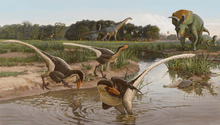Ojo Alamo Formation
The Ojo Alamo Formation is a geologic formation in New Mexico spanning the Mesozoic/Cenozoic boundary.
| Ojo Alamo Formation Stratigraphic range: Maastrichtian-Danian ~69–64 Ma | |
|---|---|
 A restoration of the environment, featuring Dineobellator (center front), Ojoceratops (right), a tyrannosaurid (far left), and Alamosaurus (center back), taxa all known from the formation. | |
| Type | Geological formation |
| Sub-units | Naashoibito Member, Kimbeto Member |
| Underlies | Nacimiento Formation |
| Overlies | Kirtland Formation |
| Lithology | |
| Primary | Conglomerate, sandstone, shale |
| Location | |
| Coordinates | 36.3305764°N 108.0350723°W |
| Region | San Juan Basin, New Mexico |
| Country | |
| Type section | |
| Named for | Ojo Alamo Spring |
| Named by | B. Brown |
| Year defined | 1910 |
Description
The Ojo Alamo formation is divided into two subunits separated by a large unconformity—a gap in the geologic record. The lower Naashoibito member (sometimes considered part of the Kirtland Formation) was deposited during the Maastrichtian age of the Cretaceous period, specifically between about 69-68 million years ago. It overlies the De-na-zin member of the Kirtland formation, though the two are separated by another large unconformity that spans a period of geologic time equivalent to 73-69 million years ago.[1] All dinosaur fossils probably come from this unit.[2]
The upper unit of the Ojo Alamo Formation is the Kimbeto Member, which was deposited mainly during the earliest Cenozoic (Danian age of the Paleogene period), between 66 and 64 million years ago.[1]
Fossils
Dinosaur remains are among the fossils that have been recovered from the formation, though all dinosaur remains come from the lowest part of the formation, the Naashoibito member (sometimes considered part of the Kirtland Formation, which dates to the late Maastrichtian stage of the Cretaceous period.[3]
Some researchers have claimed to find isolated non-avian dinosaur remains in the younger Kimbeto Member. If this is the case, it would represent the only known instance of a non-avian dinosaur population persisting after the Cretaceous–Paleogene extinction event. However, most scientists consider these to have been stratigraphically misinterpreted or reworked from the older Naashoibito member.[2]
Alamo Wash fauna
The following species are known to be present in the Naashoibito Member "Alamo Wash Fauna".[4]
- Lizards
- Peneteius
- Fish
- Myledaphus sp.
- Squatirhina sp.
- cf. Lepisosteus sp.
- ?Osteichthyes indet.
- Amphibians
- Caudata indet.
- Turtles
- Aspideretoides
- Compsemys
- cf. Hoplochelys sp.
- Neurankylus
- Plastomenus
- Adocus?
- Basilemys?
- Theropods
- Dineobellator notohesperus[5]
- Ojoraptorsaurus boerei[6]
- Ornithomimidae indet.
- Richardoestesia sp.
- Troodontidae indet.
- Tyrannosauridae indet.
- aff. Tyrannosaurus rex
- Sauropods
- Alamosaurus sanjuanensis
- Ankylosaurs
- Glyptodontopelta mimus
- Ankylosauridae indet.
- Hadrosaurids
- Saurolophinae indet.
- aff. Edmontosaurus annectens
- aff. Kritosaurus navajovius
- Lambeosaurinae indet. similar to Hypacrosaurus altispinus[7]
- Ceratopsians
- Ojoceratops fowleri
- Torosaurus utahensis
- aff. Eotriceratops xerinsularis
- Pterosaurs
- Quetzalcoatlus northropi
- Mammals
- cf. Alphadon marshi
- Alphadontinae indet.
- Essonodon browni
- cf. Glasbius sp.
- Mesodoma formosa
- cf. Meniscoessus sp.
- Multituberculata indet.
- cf. Pediomyidae indet.
History of investigation
The formation was named by Barnum Brown in 1910 for exposures near Ojo Alamo springs in the San Juan Basin.[8] Baltz et al. reassigned the lower beds to the Kirtland Formation in 1966, but this has not been generally accepted.[9]
See also
- List of dinosaur-bearing rock formations
References
- Sullivan, R.M., and Lucas, S.G. 2006. "The Kirtlandian land-vertebrate "age" – faunal composition, temporal position and biostratigraphic correlation in the nonmarine Upper Cretaceous of western North America." New Mexico Museum of Natural History and Science, Bulletin 35:7-29.
- Sullivan, RM (2003). "No Paleocene dinosaurs in the San Juan Basin, New Mexico". Geological Society of America Abstracts with Programs. 35 (5): 15. Retrieved 2007-07-02.
- Williamson, T.E. and Weil, A. (2008). "Metatherian mammals from the Naashoibito Member, Kirtland Formation, San Juan Basin, New Mexico and their biochronologic and paleobiogeographic significance. Journal of Vertebrate Paleontology, 28: 803-815.
- Jasinski, S. E., Sullivan, R. M., & Lucas, S. G. (2011). Taxonomic composition of the Alamo Wash local fauna from the Upper Cretaceous Ojo Alamo Formation (Naashoibito Member) San Juan Basin, New Mexico. Bulletin, 53, 216-271.
- Jasinski, Steven E.; Sullivan, Robert M.; Dobson, Peter (2020). "Article Open Access Published: 26 March 2020 New Dromaeosaurid Dinosaur (Theropoda, Dromaeosauridae) from New Mexico and Biodiversity of Dromaeosaurids at the end of the Cretaceous". Scientific Reports. 5105. Retrieved 26 March 2020.
- Robert M. Sullivan, Steven E. Jasinski and Mark P.A. Van Tomme (2011). "A new caenagnathid Ojoraptorsaurus boerei, n. gen., n. sp. (Dinosauria, Oviraptorosauria), from the Upper Ojo Alamo Formation (Naashoibito Member), San Juan Basin, New Mexico" (PDF). Fossil Record 3. New Mexico Museum of Natural History and Science Bulletin. 53: 418–428.
- Jasinski, Steven E.; Sullivan, Robert M.; Lucas, Spencer G.; Spielmann, Justin A. "The first "lambeosaurin" (Dinosauria, Hadrosauridae, Lambeosaurinae) from the Upper Cretaceous Ojo Alamo Formation (Naashoibito Member), San Juan Basin, New Mexico: further implications for the age of the Alamo Wash local fauna". www.researchgate.com. ResearchGate. Retrieved 21 August 2016.
- Brown, Barnum, 1910, The Cretaceous Ojo Alamo beds of New Mexico with description of the new dinosaur genus Kritosaurus: American Museum of Natural History Bulletin, v. 28, art. 24, p. 267-274.
- Baltz, E.H., Ash, S.R., and Anderson, R.Y., 1966, History of nomenclature and stratigraphy of rocks adjacent to the Cretaceous-Tertiary boundary, western San Juan basin, New Mexico, IN Shorter contributions to general geology, 1965: U.S. Geological Survey Professional Paper, 524-D, p. D1-D23.
Further reading
- Burns, Michael E. (2008). "Taxonomic utility of ankylosaur (Dinosauria, Ornithischia) osteoderms: Glyptodontopelta mimus Ford, 2000: a test case". Journal of Vertebrate Paleontology. 28 (4): 1102–1109. doi:10.1671/0272-4634-28.4.1102.